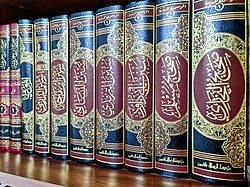Taras Shevchenko
| Author | Unknown (falsely attributed to Sulaym ibn Qays)[a] |
|---|---|
| Language | Arabic |
| Subject | Hadith |
| Genre | Hadith collection |
Publication date | partly 8th century, with many later additions |
The Book of Sulaym ibn Qays (Arabic: كِتَاب سُلَيْم بن قَيْس, romanized: Kitāb Sulaym ibn Qays) is the oldest known Shia hadith collection. It was attributed to Sulaym ibn Qays al-Hilali (died 678), who purportedly entrusted it to Aban ibn Abi Ayyash.[1]
Scholars consider the attribution of this work to Sulaym ibn Qays, who himself may have been a legendary figure, to be false.[a] The earliest known reference to the book was in the Kitāb al-Ghayba by Muhammad ibn Ibrahim al-Nu'mani (tenth century).[2][better source needed]
The precise dating of the work is not clear. Hossein Modarressi dates the original core of this work to the final years of Hisham ibn Abd al-Malik's reign (r. 723–743), which would make it one of the oldest Islamic books that are still extant.[3] However, it contains many later additions and alterations of unknown date, which may render it impossible to reconstruct the original text.[4] Two individual passages which have been the subject of a case study have been dated to c. 762-780 and to the late 8th/early 9th century, respectively.[5]
| Part of a series on |
| Hadith |
|---|
 |
|
|
Views of medieval scholars
Sources indicate that the book was well known, but not always held in high esteem. Ibn al-Nadim (d. 995) said that the book was among the well-known Shia books,[6] and Mohammad-Baqer Majlesi mentioned the book and the author in his book, Al-Ghaibah.[citation needed]
However, the scholars Ahmad ibn Ubayda (d. 941) and Abu Abd Allah al-Ghadhanfari (d. 1020) considered the book to be unreliable on the basis of three factors: a segment in the book indicates there were thirteen Imams instead of the traditionally held twelve; another segment states that Muhammad ibn Abi Bakr rebuked his dying father Abu Bakr despite Muhammad being a three-year-old child; and the book was purportedly transmitted by Aban ibn Abi Ayyash at a time when the latter was only fourteen years old.[7]
Dating
Currently, several variant manuscripts of this book exist, and it has been suggested that content was added to it and altered in it over time.[8]
An analysis of a tafsir-related passage suggests that this passage dates to the early 9th century, or perhaps the late 8th century CE.[9]
Notes
- ^ a b According to Djebli 1960–2007, "the very existence of this man, and of his work, should be regarded with caution". Modaressi 2003, pp. 82–83 calls it "obvious that such a person never existed and that the name is only a pen name". Other scholars, such as Mohammad Ali Amir-Moezzi, have been more cautious in rejecting Sulaym ibn Qays' historicity, but do agree that the attribution of the work to him is false (see Gleave 2015, pp. 85–86).
References
- ^ Modaressi 2003, p. 85.
- ^ Khetia (2013, pp. 61–62).
- ^ Modaressi 2003, p. 83.
- ^ Gleave 2015, p. 86, citing Mohammad Ali Amir-Moezzi.
- ^ Gleave 2015, pp. 86, 102.
- ^ Al-Fihrist, p. 275 in chapter titled, "Al-Fan Al-Khamis Min Al-Maqalaht Al-Saadesah".
- ^ Djebli 1960–2007.
- ^ "Ths Shi'i Imams, Wilayah and aspects of Imamology". Archived from the original on 2012-02-08. Retrieved 2007-09-25.
- ^ Gleave 2015, p. 99: "The content of the first section of the tenth report appears, then, as a rather audacious attempt to attribute to ʿAlī knowledge and mastery of exegetical techniques and a level of hermeneutic sophistication which came into existence in the late eighth/early ninth century."
Works cited
- Djebli, Moktar (1960–2007). "Sulaym b. Ḳays". In Bearman, P.; Bianquis, Th.; Bosworth, C.E.; van Donzel, E.; Heinrichs, W.P. (eds.). Encyclopaedia of Islam, Second Edition. doi:10.1163/1573-3912_islam_SIM_7152.
- Gleave, Robert M. (2015). "Early Shiite hermeneutics and the dating of Kitāb Sulaym ibn Qays". Bulletin of the School of Oriental and African Studies. 78 (1): 83–103. doi:10.1017/S0041977X15000038.
- Modaressi, Hossein (2003). Tradition and Survival: A Bibliographical Survey of Early Shīʿite Literature. Oxford: Oneworld. ISBN 1-85168-331-3.
- Khetia, Vinay (2013). Fatima as a motif of contention and suffering in Islamic sources (Thesis). Concordia University.
External links
- English Translation of Kitab al-Sulaym ibn Qays
- Rovshan Abdullaoglu. "İlk Kitab (II nəşr)" (in Azerbaijani). qedimqala.az. Archived from the original on 2015-08-19. Retrieved 2015-08-09.

 Read
Read
 AUTHORPÆDIA is hosted by Authorpædia Foundation, Inc. a U.S. non-profit organization.
AUTHORPÆDIA is hosted by Authorpædia Foundation, Inc. a U.S. non-profit organization.